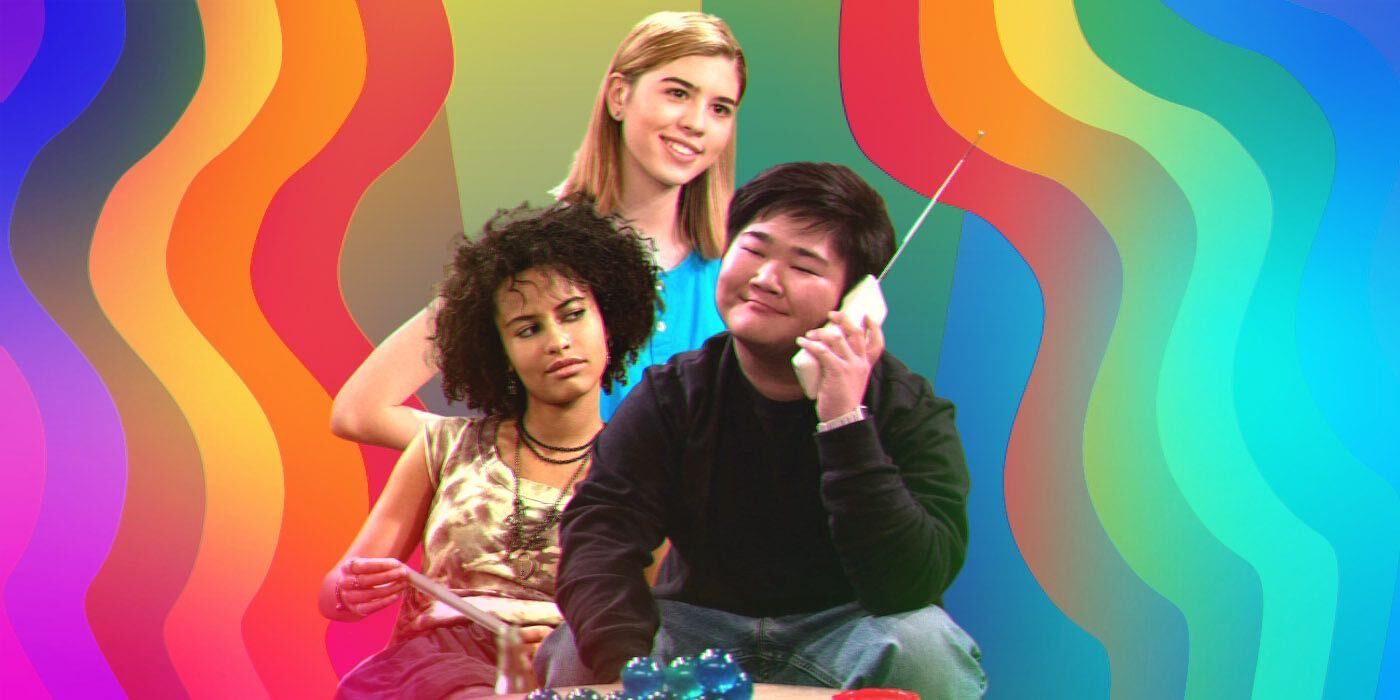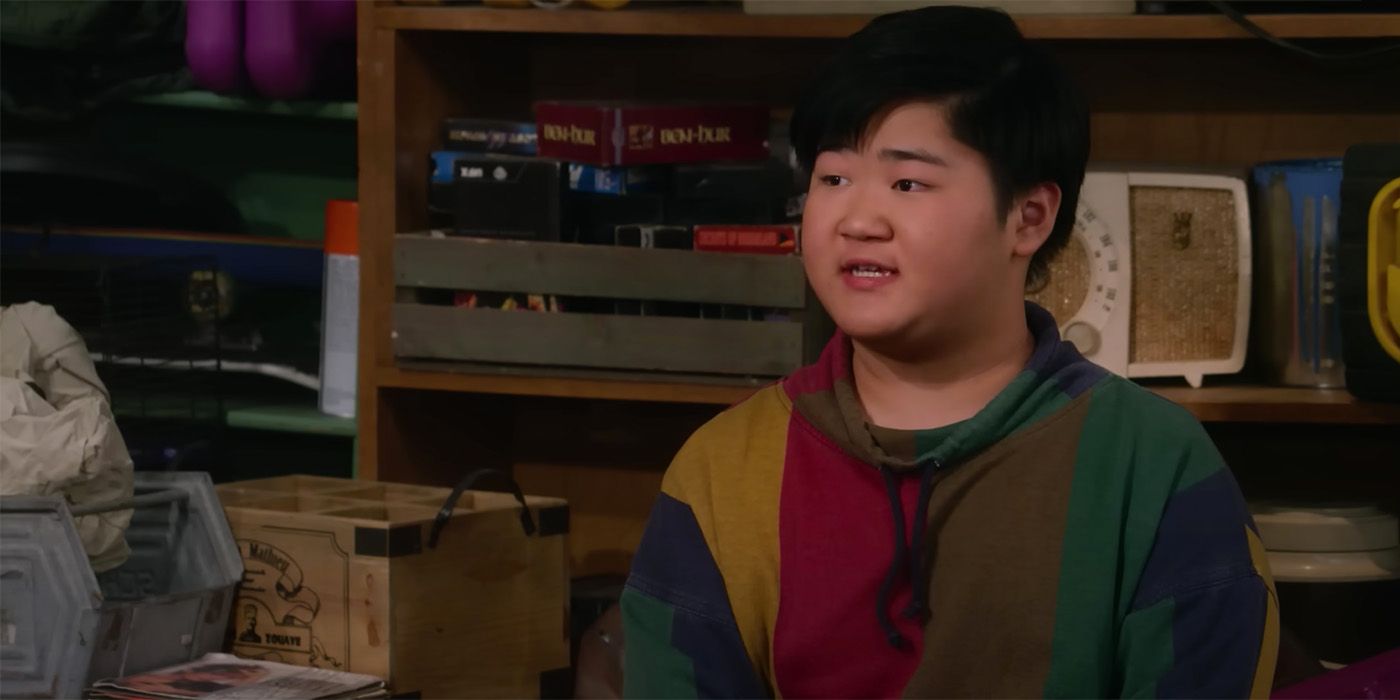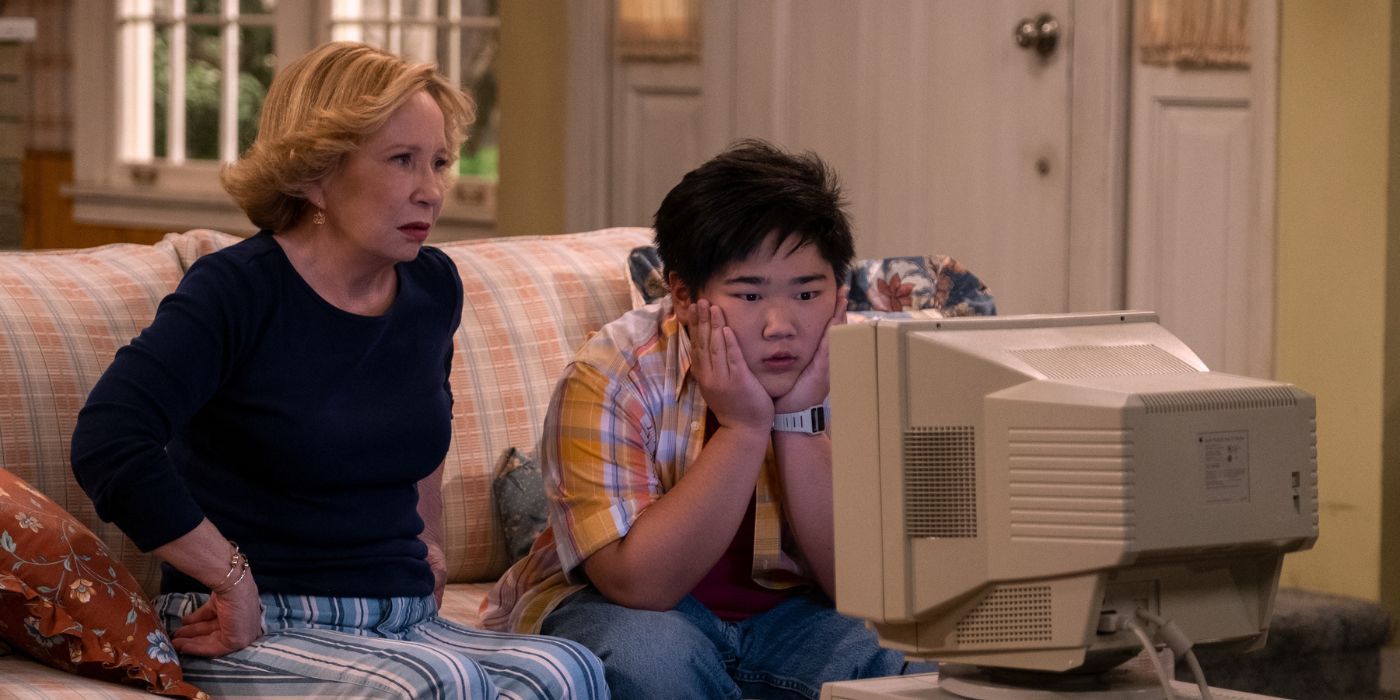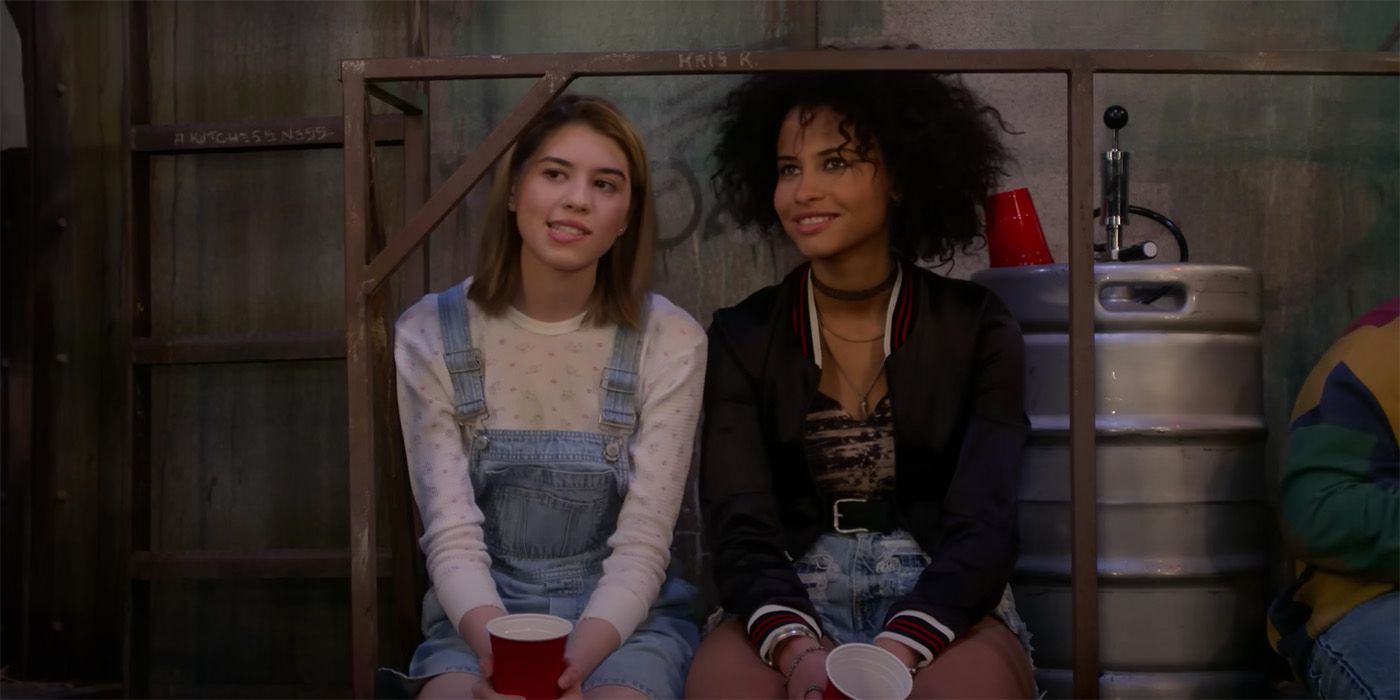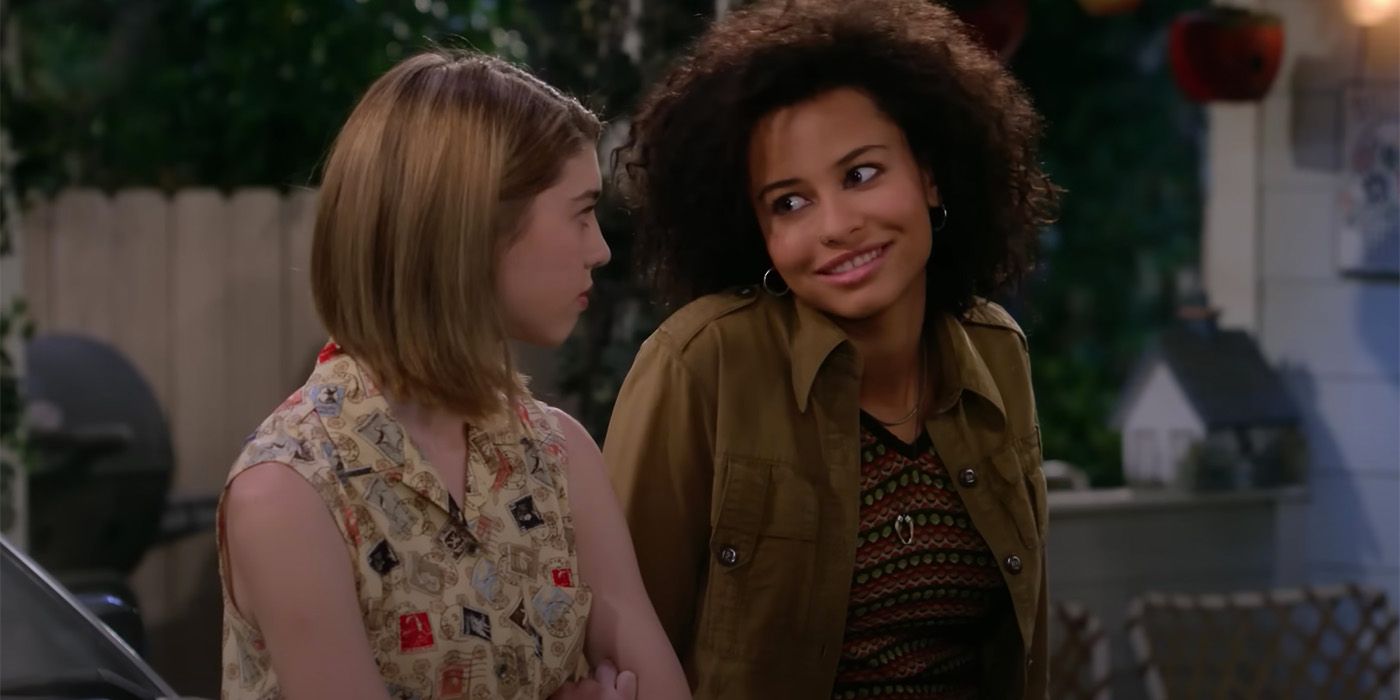Editor's note: The below contains spoilers for Season 1 of That '90s Show.Netflix's spinoff of the beloved early 2000s sitcom That '70s Show brings forth a whole new generation of basement-dwelling teens in Point Place, Wisconsin. When Leia Forman (Callie Haverda) comes to visit her grandparents for the Fourth of July, she immediately falls into a new group of friends who encourage her to stay in Point Place for the summer — missing out on Space Camp much to her father's chagrin. The first episode introduces us to a ragtag group of teenagers, much like the original series. Leia is an awkward nerd who's spent much of her life feeling invisible until she finally feels seen by her next-door neighbor Gwen (Ashley Aufderheide), a cool girl with a rebellious group of friends.
25 years after the original series first began airing, and 19 years after Eric (Topher Grace) first got the keys to the Vista Cruiser, That '90s Show brings the show into the future — or rather, the more recent past. While the new series relies on a lot of similar tropes as its predecessor, it takes a familiar story and puts it into a time frame that has recently reached a point of romanticization by younger generations. With a new decade comes all sorts of new concepts including a computer for Kitty (Debra Jo Rupp) and Red (Kurtwood Smith), raves over concerts, and the introduction of at least one queer character into the main cast of the series.
While echoes of the previous group of teens that once occupied Red and Kitty's basement two decades prior are seen throughout the new cast, it's clear that That '90s Show has made some very excellent updates to the character archetypes. Jay (Mace Coronel) and Nate (Maxwell Acee Donovan) are the himbos of the group with a slightly more wholesome "boys will be boys" vibe as compared to Kelso (Ashton Kutcher) and Hyde (Danny Masterson). That '90s Show adds another girl to the group where That '70s Show only featured Donna (Laura Prepon) and Jackie (Mila Kunis), and Leia, Gwen, and Nikki (Sam Morelos) are all distinct characters that, for the most part, escape outdated misogynist stereotypes. And then there's Ozzie (Reyn Doi), a delightfully queer addition to the group fully ready to read his friends to filth at any given moment.
Ozzie's Coming Out Journey Is a Refreshing Change From Fez's Ambiguous Sexuality
Ozzie is a welcome addition to the mix and the episode that focuses on his coming out journey is a great piece of representation that enriches That '90s Show for the better. Upon first glance, it appears that Ozzie makes up for the fact that That '70s Show never made Fez gay despite filling the character with effeminate traits and leaning into gay stereotypes in the original series. Ozzie's queerness is frequently acknowledged throughout the first season, and he's fully out with his group of friends.
That '90s Show's fifth episode, "Step By Step," centers around a part of Ozzie's self-designed 16-step coming out journey. At this point, he's reached Step 7: come out to an adult that you see all the time, and he's chosen Leia's grandma as the adult he wants to tell. Other extremely relatable steps on Ozzie's list include Step 6: coming out to strangers he'll never see again, and the final step, coming out to his parents, which is often the hardest step. As a queer person myself, I feel like this episode does a really good job of portraying what it's like to exist as a gay teenager in rural America. Ozzie explains to Leia when she's surprised he's not already out to everyone, "I'm a gay kid living in small-town Wisconsin. There are still parking spaces for horses at the courthouse. The fact that I'm out to anyone is huge."
In the episodes, we see a couple of different reactions to Ozzie's queerness. Though Leia already knows that Ozzie is gay because Leia hasn't had to come out herself we see her sort of awkwardly relate the process to telling her parents that she wanted to change instruments in the school band. For a queer person, it's not unusual to have your straight friends try to relate to your experience with their own experiences, and most of the time, as it is in Ozzie and Leia's case, they mean well despite not fully understanding how difficult the coming out process can be. Leia isn't completely clueless either, when a miscommunication botches Ozzie's first attempt to tell Kitty he's gay she immediately covers for him at her own expense.
When Ozzie finally finds the courage to tell Kitty that he's gay, it goes beautifully. The fact that Ozzie's coming out goes so smoothly is almost a breath of fresh air because it would've been easy for That '90s Show to attempt to get a joke out of the moment or to have it go poorly as a "sign of the times," but the last thing that queer audiences need right now is more traumatic depictions of our lives. The scene is somewhat reminiscent of Robin Buckley's coming out moment in Stranger Things—we're braced for Kitty to not accept Ozzie as he is, but instead, she engages in the conversation by speaking to him the same way she would any of the other kids, making a humorous but harmless comment about his Canadian boyfriend.
Rupp plays the scene beautifully, embodying the perfect grandmother figure that you'd absolutely feel at ease with. When Ozzie clarifies that she's okay with him being gay, she leaves no room for questioning by saying that of course she is, bringing him in for a hug. With all of her experience in the world, Kitty knows that it couldn't have been easy for Ozzie to tell her that he's gay and she honors that by telling him that his trust in her "made her feel very special." It's a perfectly executed scene with the power to bring tears to your eyes, especially if you've ever hoped for the kind of reaction that Ozzie gets from Kitty.
As excellent as Ozzie's coming-out episode is, there are still several areas where That '90s Show sells itself short in terms of its queer representation by not taking enough risks. As Ozzie is the only confirmed queer person on the show, it's disappointing that his love interest is "conveniently" long-distance. By making Ozzie's boyfriend someone who lives in Canada the series can effectively check the queer representation box without ever having to show explicitly queer content by having Ozzie actually get to have scenes with a romantic partner. Meanwhile, the straight teens get to date amongst the group, kiss on screen, and talk about sex. Fortunately, Wisconsin nearly borders Canada so it would be very easy for That '90s Show to bring Etienne down for the summer in Season 2.
'That '90s Show' Misses an Opportunity to Flip the Script With Leia and Gwen
Another glaring missed opportunity for queer representation stands out in the way that That '90s Show completely bypasses the opportunity to make Leia and Gwen queer in favor of an eleventh-hour plot twist that had little to no build-up during the season. In the final episode of Season 1, "Kids In America," Leia almost kisses Nate, in a scene that comes out of left field after the two bond over worrying about getting their hearts broken by Jay and Nikki. It's clear that the moment serves as a dramatic cliffhanger to add extra drama if the show gets picked up for a second season, however, That '90s Show could've achieved the exact same type of storytelling by having Leia realize that she has feelings for Gwen.
Leia's sudden feelings for Nate feel akin to narrative whiplash, particularly because the writing across the entire season perfectly sets up a potential romance between Leia and Gwen, whereas Leia and Nate's only 1-on-1 scenes occur in the final two episodes. In That '90s Show's pilot episode, Leia and Gwen are set up as the Eric and Donna of their generation. They have a meet-cute moment when Leia overhears Gwen belting Alanis Morissette from her grandparent's driveway, leading her to find Gwen and watch in awe as she dances around singing iconic angry girl music of the decade. Despite not fitting the trope itself, Gwen is literally the girl next door, putting the two of them in the same positions as Leia's parents two decades later.
The setup certainly doesn't stop there, in the pilot alone, we also get a scene of Eric saying, "all I know is I'm going to love her and stand behind her, no matter what." This is something you'd want a parent to say in most situations, but through a queer lens it's easy to interpret this as Eric being supportive of Leia were she to fall somewhere in the queer spectrum.
Aside from Leia, Gwen spends the majority of her free time in the season paired up with Ozzie, and as any queer person will tell you, birds of a feather flock together. Gwen is easily the most liberal teen of the group, and she's also the only person other than Ozzie to not spend a significant portion of the season embroiled in a romance. When Leia is on the quest to get her first kiss, That '90s Show has ample opportunity for Gwen to volunteer, even having her say that she has an "idea" that she didn't want to mention because it felt "weird and desperate." When she suggests Jay, it reads as if the writing opted for the easy way out and a rather clunky prop for Leia's main romantic arc of the season. In fact, the writing for this particular episode leans so "no homo" for Leia that they have her practically assault a boy at the mall for her first kiss, when she could've easily shared the experience consensually with a friend.
The penultimate episode, "Dirty Double Booker," also perfectly lends itself to having Gwen be the person that Leia has feelings for in the finale by having the story center around her being torn between spending her last weekend with Jay or Gwen, both of whom equally wish to get as much time with her as possible before she has to leave for the school year. Leia makes plans with Jay and Gwen at the same time and then spends the entire day attempting to rush through her date with Jay in order to spend time with Gwen. During a moment of frustration, she even snaps "I was supposed to be done with you by now." Because she's so torn between the two, Leia effectively ruins her chance to spend any meaningful time with either of them.
By the end of Season 1, Leia effectively makes up with Gwen, but her feelings for Jay are complicated by her sudden romantic entanglement with Nate. If That '90s Show finds similar success to That '70s Show, the series will have plenty of opportunities to explore romantic connections between any combination of the teens. Over the course of That '70s Show's seven seasons Donna dated Casey Kelso and Randy Pearson, and the series even toyed with a romance between her and Hyde before ultimately circling back to Donna and Eric's endgame romance. Hopefully, That '90s Show will get more seasons to continue building out this story and exploring what it's like to be a queer teenager in the 90s. Ultimately, in terms of queer representation, That '90s Show vastly improves upon the original series, but the show sells itself short by playing it safe.
All 10 episodes of That '90s Show Season 1 are now available to stream on Netflix.

